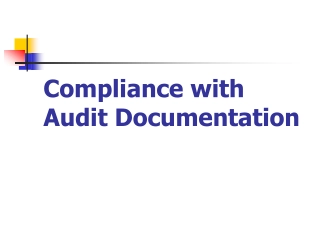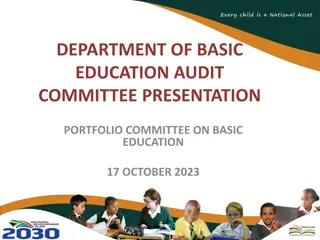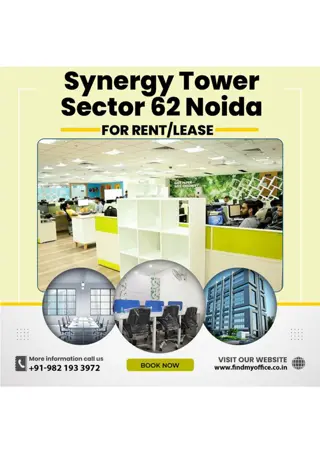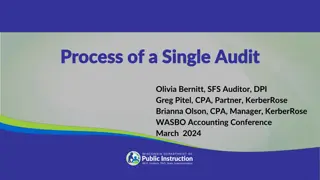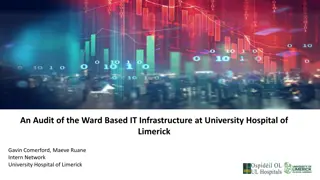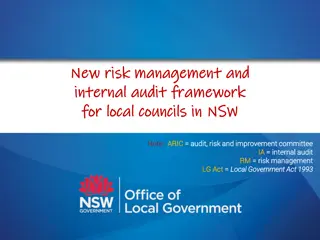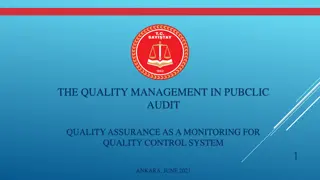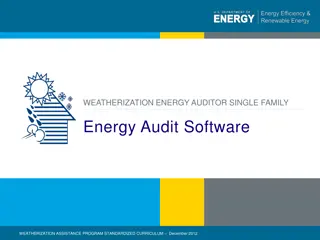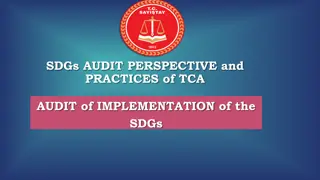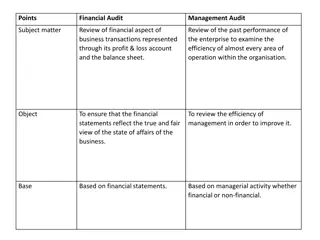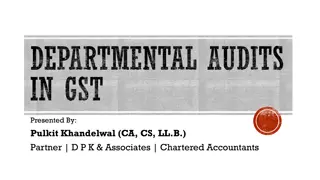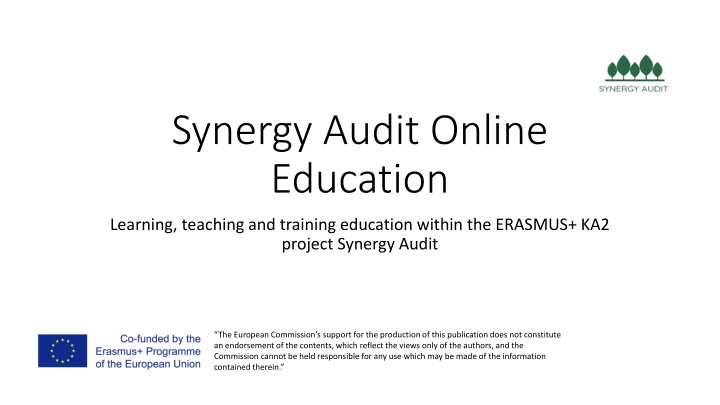
Synergy Audit Online Education
This presentation on Synergy Audit Online Education & Training offers a comprehensive exploration of environmental management and audits. It aims to provide a holistic understanding for organizations, encouraging the implementation of internal environmental audits to reduce environmental impact. Developed by partner organizations in the ERASMUS+ project, it serves as a valuable resource for multidisciplinary learning and proactive environmental practices.
Download Presentation

Please find below an Image/Link to download the presentation.
The content on the website is provided AS IS for your information and personal use only. It may not be sold, licensed, or shared on other websites without obtaining consent from the author. If you encounter any issues during the download, it is possible that the publisher has removed the file from their server.
You are allowed to download the files provided on this website for personal or commercial use, subject to the condition that they are used lawfully. All files are the property of their respective owners.
The content on the website is provided AS IS for your information and personal use only. It may not be sold, licensed, or shared on other websites without obtaining consent from the author.
E N D
Presentation Transcript
Synergy Audit Online Education Learning, teaching and training education within the ERASMUS+ KA2 project Synergy Audit The European Commission s support for the production of this publication does not constitute an endorsement of the contents, which reflect the views only of the authors, and the Commission cannot be held responsible for any use which may be made of the information contained therein.
What does this presentation involve and how can I use it? This presentation is prepared as a possibility for a multidisciplinary set of organisations to take usage from when learning about and teaching forward knowledge about environmental management and environmental audits from an interdisciplinary perspective, toward organisations. The knowledge in the presentation have been elaborated by partner organisations in the Synergy Audit project and is based on previous knowledge and experience from each of the partner organisations, together with knowledge input from data gathering and State of the art assessment in the ERASMUS+ Synergy Audit project (2019-2022). The presentation is adviced to use as a sort of encyclopedia which point out certain relevant areas of knowledge within environmental science, environmental management, energy audits, contemporary history, teaching pedagogics and more as a help to grasp a holistic understanding about reasons for working with environmental management and its internal environmental audits. It is our wish that this presentation will create curiosity for one or more areas of knowledge in the presentation and thereby inspire for further knowledge intake within specific areas. Also, it is our main wish that this presentation will inspire you and your organisation to start up, and carry out environmental management and internal environmental audits in your organisation, for the chance to decrease environmental and climatic negative impact from activities performed by the organisation. In this we all have a role to play, and we wish you all the best of luck on your journey forward with this mission. The project partners of Synergy Audit
Day 1 Day 1
Introduction to the Synergy Audit Online Course o Elaborated by the project partners of the Synergy Audit ERASMUS+ Project (2019-2022) o This learning, teaching and training education have been performed as a pilot training and as a finalized online training in the project. o The course involve lectures, seminars and workshops together with real environmental audit training toward organisations. o Course Aim: to make sure that you get more knowledge about environmental audits by an interdisciplinary perspective to thereby make sure that you will be ready to perform internal environmental audits in your home organisation after the course ending. o Help to improve the chance for your home organisation to be environmentally certified.
Lecture 1 Lecture 1
Climate change Climate change Why do we perform audits?
Effects Of Global Climate Change? Temperatures Will Continue To Rise The melting of polar ice caps. Rising sea levels The increasing frequency and intensity of extreme weather events The extinction of animal and plant species More frequent heat waves The emergence of climate refugees Agriculture and livestock issues that could exacerbate hunger around the world The degradation of economic resource
Consequences of a changing climate Temperatures Will Continue to Rise Frost-free Season (and Growing Season) will Lengthen Changes in Precipitation Patterns More Droughts and Heat Waves Hurricanes Will Become Stronger and More Intense Sea Level Will Rise 1-8 feet by 2100 Arctic Likely to Become Ice-Free
Most emissions come from just a few countries
Global warming tipping points will push us over climate cliff
Tipping points effects and domino effects Amazon rainforest Arctic sea ice Atlantic circulation Boreal forest Coral reefs And more, and more .
Meeting Climate Change Adaptation Mitigation Resilience Transformation
EU Adaptation Strategy Extreme weather threat makes climate change adaptation a top priority Smarter adaptation Faster adaption More systemic adaptation Stepping up international action for climate resilience
Water is not a commercial product like any other but, rather, a heritage which must be protected, defended and treated as such. Directive 2000/60/EG preambel
Water, source of conflicts? In dry regions control of water could result in conflicts? 1.5 billion people do not have access to clean water 2 billion people do not have access to satisfactory sanitation 2.5 % of all water is sweet water
More than 97% of all water is salty, of which 1% is brackish water. Only 0.25% of the world's water is sweet. It is available in frozen form. The rest is surface water and groundwater. In arid regions, the availability of water is a power factor
Water scarcity and drought in Europe European water Water Frame Directive Water scarcity Drought Desalination Irrigation of golf courses Tourism Agreement between states Albufeira Convention
The threats Eutrophication Environmental pollutants Alien species Physical disturbance Exploitation Shredding Flash drought
Aral lake syndrome one of the Aral lake syndrome one of the worst mistakes in modern history worst mistakes in modern history
Climate change: the silent threat that could cause 50% of the world's species to disappear by the year 2100
Climate and biodiversity are interdependent
What is biodiversity and how does climate change affect it?
What are ecosystem services and why are they needed? What are ecosystem services? The impact of climate on ecosystems Land use is central to both climate and biodiversity
EU Biodiversity Strategy for 2030 EU Biodiversity Strategy for 2030 Give nature a greater place in our lives Give nature a greater place in our lives The MISSION Take effective and urgent action to halt the loss of biodiversity in order to ensure that by 2020 ecosystems are resilient and continue to provide essential services, thereby securing the planet s variety of life, and contributing to human well-being, and poverty eradication.
The VISION The VISION Living in harmony with nature Living in harmony with nature By 2050, biodiversity is valued, conserved, restored and wisely used, maintaining ecosystem services, sustaining a healthy planet and delivering benefits essential for all people.
Can nature get it right? Earth, our common home in the universe, also has rights Nature has legal rights? The Rights of Mother Earth Panama gives nature rights Large river in Canada has been granted legal rights Whanganui river in New Zeeland
Lecture 2 Lecture 2
From environmental consciousness to enviromental law Why history matters?
From environmental conscious Mankind and nature: Premodern timesromental law A moral universe Anthropocentrism metaphors
Mankind and nature: modern times Carthesian Truth From Linneus to Darwin Romanticism Utopian socialism Ecocentric ethics: 1930s & 1940s
Environmental consciouness: 1962-1968 Literature, not action. Science, deep but confined to libraries. Silent Spring (1962) and its impact.
Environmental consciousness: 1974-1980s A moment of specialization in enviromental activism Turning points: Three Miles Island (1979) and Chernobyl (1986)
International Environmental Law: From the UN to Stockholm 1972 Pre-UN treaties impact: none. Stockholm Conference on the Human Environment: it sets the enviroment on the global agenda. The story continues
International Environmental Law: From Stockholm to Paris Direct and indirect impact of Stockholm conference Non-binding principles Brundtland Report 1987 (UN) Rio de Janeiro (1992) Kyoto (1997) Paris (2015)
Environmental Impact Assessment Born in the USA Stockholm 1972 UNEP (1978) World Charter for Nature (1982), UNCLOS (1982), Agenda 21 EC (1988) => EU (2001)
Reflect on: Human-nature relationship viewed in historical perspective Environmental consciouness and international law of the present times from a historical perspective
Day 2 Day 2
Lecture 3 Lecture 3
Introduction to environmental audits A multidisciplinary zoom out and zoom in perspective
Introduction to environmental audits A zoom out perspective General knowledge necessary in for example: Climate change, global warming, energy efficiency, circularity, waste management Multidisciplinary challenge a need for both public and private orgs. Environmental Management System (hereinafter referred to as EMS) Work Environmental certification by, ISO 14001:2015 EMAS
The EMS in brief a zoom out perspective 1. Leadership decision about integration of EMS into the organisation. 2. Planning of an EMS organisation in which responsibility is clarified within each activity area. 3. Knowledge gain about the reason for EMS work and the tool as such. 4. Communication plan for the EMS work. 5. Environmental investigation which consist of a review of all environmental aspects that the organisation creates with an assessment of environmental impact from the activities toward the organisation and the surrounding society. The assessment shall be performed in a quantitative and qualitative manner (usually updated every 5th year in accordance with obligations from ISO and EMAS Standards).
The EMS in brief a zoom out perspective 6. Elaboration of an environmental policy for the organisation for communication internally in the organisations and toward the surrounding society, for example stakeholder and interests. 7. Planning of an Environmental Goals and Action Plan (usually updated every 3rd year in accordance with obligations from ISO and EMAS Standards). 8. Planning and management of EMS documentation. 9. Planning and management of routines in support of the EMS. 10. Communication support of the EMS work to each person in the organisation.
The EMS in brief a zoom out perspective 11. Educative support of the EMS work toward each person in the organisation. 12. Follow-up on the EMS work in the organisation. 13. Organisation- and management of Internal Environmental Audits (hereinafter referred to as IEA). 14. Organisation and management of a yearly management review. 15. Analysis of the EMS work with a management review for development of the EMS and therefore continuous improvement. 16. Budget organisation and management at yearly occasions.
ISO 14001 Invented by the industry Global standard used in a multidisciplinary set of organisations Involve requirements to manage a strategic and effective EMS Interest from stakeholders and customers
EMAS Implemented by the EU in 2009 Very similar to the ISO 14001 standard Global usage Differentiates with the ISO standard by for example need of: Full legal compliance Full transparency externally of the EMS
Environmental management system A zoom in perspective Plan 1. Leadership decision about integration of EMS into the organisation (IEA check the documents) 2. Planning of an EMS organisation in which responsibility is clarified within each activity area. (IEA check the documents) 3. Knowledge gain about the reason for EMS work and the tool as such (IEA check the activities) 4. Communication plan for the EMS work (IEA check whether this work)

